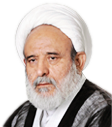|
After the death of Yazid, there was much confusion. Marwan, who was banished by the Prophet (s) and then allowed to come back by the first caliph, now assumed power. His reign was in dispute and even the Sunnis do not recognise him as a caliph. Within a year, he passed away. He had nominated his son Abdul Melik as his successor in the rule. Thus, the long cherished dream of Abu Sufyan was reralised and for nearly a century, the Umayyads tossed around the ball of caliphate among themselves. Marwan could control only Syria and Palestine at first. After the martyrdom of Mohammad bin Abu Bakr, Egypt also came under his rule. The notorious Ubaidullah ibn Ziyad was his commander in chief, and persons like Umar bin Sa’d, Hussayn bin Numair, Shimr bin Thil Joushan, and other such cruel and tyrannous persons were heading the [1] For a detailed account, see Masa’ibush Shia, vol. 3 p. 215-227 [1966].
[2] Masa’ibush Shia, vol. 3 p. 226, quoting at-Tabari’s Tarikh, vol. 8 p. 159. |
|
divisions of the army and cavalry. However, Marwan lived hardly for a year after coming into power. The rule of Abdul Melik bin Marwan lasted for twenty-one years that were full of oppression and persecution. Any person, who was even suspected to be a sympathiser with the Ahlul Bayt, was imprisoned, banished, or killed for no other fault. Mu’awiya, in his time, imprisoned several noble and innocent men. Sulayman bin Surad al-Khuza’iy, al-Musayyab bin Naqaba al-Fazari, Abdullah bin Sa’d bin Nafi’ al-Azdi, Abdullah bin Wal at-Taimi, Rifa’ah bin Shaddad al-Bajali, Abdullah bin Sa’d bin Nufeil, Muttaqi bin Muhrisa, Sa’eed bin Huthaifa, Katheer bin Amr al-Muzani, Sa’eed bin Sa’eed al-Hanafi, Abdullah bin Handhala at-Ta’iy, Abul Huwayrith al-Abdi, and their group of 4500 men known as the Tawwabin (repentants), several of whom were companions of the Prophet (s) and of Imam Ali (a.s.) and were noble men in their tribes, were imprisoned by Mu’awiya on account of their love to Imam Ali. Therefore, they could not participate in the battle of Karabala. When Yazid died, pandemonium broke out and the public looted the treasury, broke open the lock of the prisons and released all prisoners. Under Sulayman bin Surd al-Khuza’iy, the Tawwabin wanted to seek revenge for Imam Husain’s blood. Ubaidullah ibn Ziyad sent an army of twelve thousand men under the command of Hussayn bin Numair. Ubaidullah himself headed and army of thirty thousand men. Most of the Tawwabin, numbering over five thousand, were killed by Ibn Ziyad and Hussayn bin Numair’s men. A few Tawwabin escaped and went back to their native places. Ubaidullah ibn Ziyad and Hussayn bin Numair were killed near Mosul by the men of Ibrahim bin Malik al-Ashtar and al-Mukhtar. Abdul Melik bin Marwan appointed al-Hajjaj ibn Yousuf ath-Thaqafi as the governor of Iraq, al-Muhallab bin Abi Sufrah as the governor of Persia, Hisham bin Isma’eel and his son over Egypt, Musa bin Nuseir as the governor of Yemen, al-Hajjaj’s brother Mohammad bin Yousuf as the governor of Algeria. All these persons were vicious, cruel, and barbaric murderers.[1] [1] Masa’ibush Shia, vol. 4 p.50 quoting Allama Kamaluddin ad-Dimyari’s Hayatul Haiwan, vol. 1p. 55.
|
|
We may gauge the character of al-Hajjaj bin Yousuf from the incident when he climbed the pulpit and asked the congregation, “Who gives you the daily bread; the Caliph or the messenger of Allah?”[1] Al-Hajjaj had the greatest contempt towards the Prophet (s) as well as towards the people of Medina and Mecca in general. He used to boast, “Had I not been restrained, due to political necessity, by the caliph Abdul Melik bin Marwan, I would have killed the people of Mecca and Medina and put their corpses in sacs of donkey skin, for these people bear a grudge against the caliph and are jealous of his affluence.” In the year 72 AH, Abdul Melik sent al-Hajjaj bin Yousuf with an army of two thousand Syrians to subdue Abdullah bin az-Zubair whose son Mus’ab had been already killed. Instead of Medina, al-Hajjaj went to Iraq and sent men from there to Arafa in the Arabia. Abdullah ibn az-Zubair also was collecting and sending men who fought and were defeated by the army of al-Hajjaj. Since Abdullah ibn az-Zubair had established himself in the Kaaba, al-Hajjaj wrote to Abdul Melik seeking permission to enter the Kaaba. Abdul Malik gave permission and sent a contingent of five thousand soldiers headed by Tariq bin Amr to assist al-Hajjaj.[2] Abdullah ibn az-Zubair was killed in Mecca in the last days of the year 71 AH. Al-Hajjaj killed Hamadan a bondsman and caller of Azan of Imam Ali.[3] He also slaughtered Qambar another bondsman of Imam Ali,[4] and beheaded Kumail ibn Ziyad, Imam Ali’s close companion.[5] He also killed Umair [or Umar] bin ad-Dhabbi an old man of 90 years.[6] Al-Hajjaj inflicted four hundred whiplashes on Utba bin Sa’d for refusing to curse Imam Ali (a.s).[7] During his governorship of eleven years under the rule of Abdul Melik bin Marwan and nine years under the rule of al-Waleed bin Abdul Melik, al-Hajjaj killed 1,20,000 Shia in Kufa and Basra for the only [1] Ibid., p.54.
[2] Masa’ibush Shia, vol. 4 p.59 quoting at-Tabari’s Tarikhul Umam wal Muluk, vol. 1 p. 175, 360 Al-Bidaya, and al-Balathuri’s Ansabul Ashraf. [3] Masa’ibush Shia, vol. 4 p.150 quoting Manaqib of ibn Shahr Ashub, vol. 3 p. 162. [4] Ibid., p.157, quoting Biharul Anwar, vol. 9 p. 714. [5] Ibid., p.161 quoting al-Bidaya wal Nihaya, vol. 9 p. 47. [6] Ibid., p.164. [7] Ibid., p.186. |
|
reason that they were sympathisers with Imam Ali.[1] When al-Hajjaj died thirty thousand men and twenty thousand women, who had been imprisoned by him, were released Abu Sadiq Sulaym bin Qais al-Hilali was a companion of the Prophet (s), and of five Imams; namely, Imam Ali, Imam Hasan, Imam Husain, Imam Zainul Aabidin, and Imam Mohammad al-Baqir (peace be on them). When al-Hajjaj became the governor of Iraq, he ordered Sulaym to be arrested. Sulaym hid himself in various countries, and he suffered immensely and died in exile. His book under the title ‘Kitab Sulaym Bin Qays’ is translated into English. It throws new light on the incidents that occurred in the year 11 AH, and thereafter. Sa’eed bin al-Musayyab was a well-known successor of the Prophet’s companion (Tabi’een) and a companion of Imam Ali. Abdul Melik bin Marwan wanted to get married to Sa’eed’s beautiful daughter, but Sa’eed married her to a poor young man. In his anger, Abdul Melik ordered Sa’eed to be whipped thirty times for refusing to accept him as the caliph. The old man died in the year 94 AH.[2] Sa’eed ibn Jubeir was a companion of Imam Ali (a.s). He was caught by al-Hajjaj and slaughtered in the year 94 AH. Sa’eed cursed al-Hajjaj, and within a few months, al-Hajjaj died. Al-Waleed bin Abdul Melik poisoned Imam Zainul Aabidin (a.s.) on 25th Muharram, 95 AH. Sulayman bin Abdul Melik succeeded al-Waleed in the rule. He released three hundred thousand prisoners (men and women) who had been jailed by al-Hajjaj.[3] The release was not due to any mercy or pity, but because it cost the exchequer too much. Sulayman poisoned Abdullah bin Mohammed bin Ali bin Abi Talib. Hisham bin Abdul Melik succeeded his brother Sulayman in the rule and died in 125 AH. He poisoned Imam Mohammad al-Baqir (a.s.) and Abul Hasan Zaid bin Ali. He demolished the house and cut off the tongue of al-Kumait al-Asadi, a poet who wrote in favour of the Ahlul Bayt. [1] Ibid., p.93 quoting Muruj ath-Thahab of al-Mas’udi, vol. 3 p.175 and Mukhtasar Tarikh of Ibn Asakir, vol. 4 p.70.
[2] Masa’ibush Shia, vol. 4 p.181. [3] Ibid., p.190 quoting Manaqib of ibn Shahr Ashub, vol. 2 p. 107, Hayatul Haiwan vol. 1 p. 55. |
|
Haleef al-Qur’an Abul Husain Zaid bin Ali Bin al-Husain bin Ali bin Abi Talib was killed along with his three hundred and thirteen followers by an army of Yousuf bin Umar by the orders of Hisham bin Abdul Melik. He then hung the corpse of Zaid on the main entrance to Kufa. The corpse remained hung for five years. A pleasant smell emanated from the corpse. This happened in the year 121 AH. In the same way, Mohammad bin Ali al-Kufi was slaughtered the next year. When al-Waleed bin Yazid bin Abdul Melik became the king, he sought to arrest Yahya bin Zaid, who resisted against ten thousand warriors just with the help of seventy followers. Zaid and his followers were martyred. Zaid’s head was severed and sent to al-Waleed bin Yazid, and his body was hung on the gateway of Jurjan for one year. Khushkhash al-Azdi, who escaped death in the battle, was taken to Nasiruddin Sayyar. Al-Azdi’s hands and feet were first severed, and then he was martyred. |
source : http://www.maaref-foundation.com













